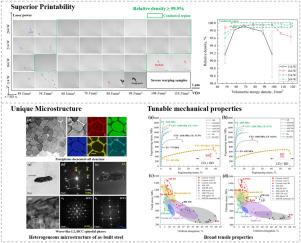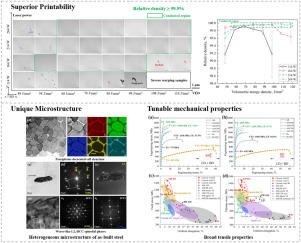A novel age-hardenable austenitic stainless steel with superb printability
IF 9.3
1区 材料科学
Q1 MATERIALS SCIENCE, MULTIDISCIPLINARY
引用次数: 0
Abstract
Precipitation-hardened high strength alloys, such as nickel-based alloys, aluminum alloys and stainless steels, are susceptible to hot cracking during 3D printing. This issue is typically mitigated by reducing solute segregation or promoting columnar-to-equiaxed transition. Here, we demonstrate an alternative approach by increasing segregation solutes, especially Ti element, to reduce hot cracking during laser powder bed fusion (LPBF) additive manufacturing of a new austenitic stainless steel (ASS). Enhanced segregation triggers peritectic-like reactions at cell/grain boundaries, forming multiple phases that bridge FCC dendrites. As a result, the new ASS exhibited excellent printability across a broad range of processing parameters. The as-built (AB) steel displayed a heterogeneous columnar grain microstructure with fine L21/BCC/C14 precipitates partially decorating cell structures, achieving a yield strength (σ0.2) above 690 MPa and uniform elongation (εu) beyond 17.5 %. The epitaxial growth of the columnar grains was frequently interrupted by puddles of fine grains, leading to near-isotropic tensile properties. Following isochronal annealing at temperatures between 600 and 1150 °C for two hours, the AB steel underwent varying degrees of microstructure evolution, resulting in a broad range of mechanical properties (σ0.2 from 300 to 1460 MPa and εu from 59.5 % to 7.6 %). This high strength is attributed to the formation of the L21/σ/η multiple phases at cell and grain boundaries, in combination with coherent L12-ordered (γ') nanoparticles precipitated within cell interiors during aging. This study explored that compositional design leveraging the unique solidification behavior of the LPBF process can produce hierarchical-structured stainless steels with excellent printability and tunable mechanical performance.


一种新型时效硬化奥氏体不锈钢,具有极佳的可印刷性
沉淀硬化的高强度合金(如镍基合金、铝合金和不锈钢)在 3D 打印过程中容易出现热裂纹。这一问题通常通过减少溶质偏析或促进柱状向等轴状转变来缓解。在此,我们展示了另一种方法,即通过增加偏析溶质(尤其是钛元素)来减少新型奥氏体不锈钢(ASS)激光粉末床熔融(L-PBF)增材制造过程中的热裂纹。强化偏析会在晶胞/晶粒边界引发类似包晶的反应,形成桥接 FCC 树枝状的多相。因此,新型 ASS 在广泛的加工参数范围内都表现出优异的可印刷性。坯钢(AB)显示出异质柱状晶粒微观结构,细小的 L21/BCC/C14 沉淀部分装饰了晶胞结构,屈服强度(σ0.2)超过 690 兆帕,均匀伸长率(εu)超过 17.5%。柱状晶粒的外延生长经常被细小晶粒的水坑打断,从而导致近乎各向同性的拉伸特性。在 600 至 1150 °C 之间的温度下进行两小时等速退火后,AB 钢经历了不同程度的微观结构演变,从而获得了广泛的机械性能(σ0.2 从 300 到 1460 MPa,εu 从 59.5% 到 7.6%)。这种高强度归因于晶胞和晶粒边界形成的 L21/σ/η 多相,以及老化过程中晶胞内部析出的相干 L12 有序 (γ')纳米颗粒。本研究探讨了利用 L-PBF 工艺独特的凝固行为进行成分设计,可生产出具有出色的可印刷性和可调机械性能的分层结构不锈钢。
本文章由计算机程序翻译,如有差异,请以英文原文为准。
求助全文
约1分钟内获得全文
求助全文
来源期刊

Acta Materialia
工程技术-材料科学:综合
CiteScore
16.10
自引率
8.50%
发文量
801
审稿时长
53 days
期刊介绍:
Acta Materialia serves as a platform for publishing full-length, original papers and commissioned overviews that contribute to a profound understanding of the correlation between the processing, structure, and properties of inorganic materials. The journal seeks papers with high impact potential or those that significantly propel the field forward. The scope includes the atomic and molecular arrangements, chemical and electronic structures, and microstructure of materials, focusing on their mechanical or functional behavior across all length scales, including nanostructures.
 求助内容:
求助内容: 应助结果提醒方式:
应助结果提醒方式:


